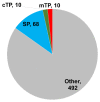Transcriptional Changes in Damask Rose Suspension Cell Culture Revealed by RNA Sequencing
- PMID: 38475449
- PMCID: PMC10934739
- DOI: 10.3390/plants13050602
Transcriptional Changes in Damask Rose Suspension Cell Culture Revealed by RNA Sequencing
Abstract
Damask roses (Rosa x damascena) are widely used in cosmetics and pharmaceutics. Here, we established an in vitro suspension cell culture for calli derived from damask rose petals. We analyzed rose suspension cell transcriptomes obtained at two different time points by RNA sequencing to reveal transcriptional changes during rose suspension cell culture. Of the 580 coding RNAs (1.3%) highly expressed in the suspension rose cells, 68 encoded cell wall-associated proteins. However, most RNAs encoded by the chloroplasts and mitochondria are not expressed. Many highly expressed coding RNAs are involved in translation, catalyzing peptide synthesis in ribosomes. Moreover, the amide metabolic process producing naturally occurring alkaloids was the most abundant metabolic process during the propagation of rose suspension cells. During rose cell propagation, coding RNAs involved in the stress response were upregulated at an early stage, while coding RNAs associated with detoxification and transmembrane transport were upregulated at the late stage. We used transcriptome analyses to reveal important biological processes and molecular mechanisms during rose suspension cell culture. Most non-coding (nc) RNAs were not expressed in the rose suspension cells, but a few ncRNAs with unknown functions were highly expressed. The expression of ncRNAs and their target coding RNAs was highly correlated. Taken together, we revealed significant biological processes and molecular mechanisms occurring during rose suspension cell culture using transcriptome analyses.
Keywords: RNA sequencing; callus; rose; suspension cells; transcriptome.
Conflict of interest statement
Authors Soo-Yun Kim, Euihyun Kim, Seung Hye Paek, Jiyeon Kim, Jihyeok Song, Kyoungyeon Heo, Jiae Min, Jeong Hun Lee, and Sang Hyun Moh were employed by the company BIO-FD&C Co., Ltd. The remaining authors declare that the research was conducted in the absence of any commercial or financial relationships that could be construed as a potential conflict of interest.
Figures







Similar articles
-
Microsatellite analysis of Rosa damascena Mill. accessions reveals genetic similarity between genotypes used for rose oil production and old Damask rose varieties.Theor Appl Genet. 2005 Aug;111(4):804-9. doi: 10.1007/s00122-005-2066-9. Epub 2005 Jun 10. Theor Appl Genet. 2005. PMID: 15947904
-
Effect of aromatherapy with Damask rose on alleviating adults' acute pain severity: A systematic review and meta-analysis of randomized controlled trials.Complement Ther Med. 2021 Jan;56:102596. doi: 10.1016/j.ctim.2020.102596. Epub 2020 Oct 18. Complement Ther Med. 2021. PMID: 33197671
-
Do Abiotic Stresses Affect the Aroma of Damask Roses?Plants (Basel). 2023 Sep 28;12(19):3428. doi: 10.3390/plants12193428. Plants (Basel). 2023. PMID: 37836168 Free PMC article. Review.
-
Triparental origin of Damask roses.Gene. 2000 Dec 23;259(1-2):53-9. doi: 10.1016/s0378-1119(00)00487-x. Gene. 2000. PMID: 11163961
-
Microsatellite analysis of Damask rose (Rosa damascena Mill.) accessions from various regions in Iran reveals multiple genotypes.BMC Plant Biol. 2007 Mar 8;7:12. doi: 10.1186/1471-2229-7-12. BMC Plant Biol. 2007. PMID: 17346330 Free PMC article.
Cited by
-
Trends and Prospects of Genetic and Molecular Research in Plants.Plants (Basel). 2024 Jun 3;13(11):1545. doi: 10.3390/plants13111545. Plants (Basel). 2024. PMID: 38891353 Free PMC article.
References
-
- Das P., Nanda S. Medicinal efficacy of rose plant: A mini review. PharmaTutor. 2015;3:23–26.
-
- Basu S., Zandi P., Cetzal-Ix W., Sengupta R. The genus Rosa: An aristocrat from the plant family with class, color and fragrance. Iran Soc. Environ. 2015:1–9.
-
- Agaoglu Y. Rose oil industry and the production of oil rose (Rosa damascena Mill.) in Turkey. Biotechnol. Biotechnol. Equip. 2000;14:8–15. doi: 10.1080/13102818.2000.10819079. - DOI
-
- Kaul V., Virendra S., Bikram S. Damask rose and marigold: Prospective industrial crops. J. Med. Aromat. Plant Sci. 2000;22:313–318.
Grants and funding
LinkOut - more resources
Full Text Sources

